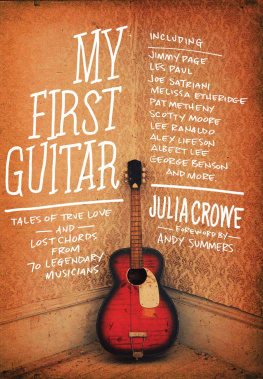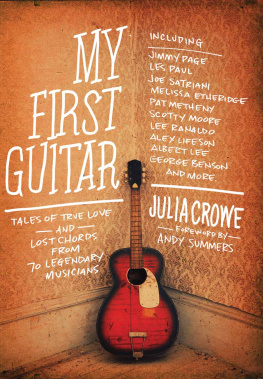

THE STRAT IN THE ATTIC
Thrilling Stories of Guitar Archaeology
DEKE DICKERSON
Foreword by Jonathan Kellerman

Contents

Sure, its all about Adirondack spruce and Brazilian rosewood, birds-eye maple and Honduran mahogany configured in just the right way to evoke that tone. Ditto PAFs, Bigsby hand-tooled wizardry, Bakelite in its most voluptuous incarnation, the perfect capacitor. But lacking human hands to caress them, guitars want to go back to being trees. And while no armchair psychological analysis will ever come close to fully explaining the seductive power vintage stringed instruments wield over the geeks who pursue them, the interaction between corporeal and inanimate is surely a major factor.
Which brings us to this marvelous book, a perfect amalgam of precisely the kind of juicy details and vivid descriptions of rare and idiosyncratic instruments that guitar freaks crave and the compelling stories of the people whose lives have become enmeshed with these 6- (and 4- and 8-and 12-) string masterpieces.
On top of that, its a great read. Deke Dickersons love for guitars and his genius for finding some of the rarest birds in the musical aviary is matched by his not inconsiderable writing chops. The man knows how to tell a great story.
So slip your favorite wax cylinder on the Victrola, settle down with your libation of choice, and immerse yourself in the world of guitarchaeology. Itll be time well spent.
Jonathan Kellerman

Holy Grail. 1950 John DAngelico Excel archtop. Nigel Osbourne/Redferns/Getty Images

What is it about vintage guitars that gets our blood flowing? Collectors of all stripes, be it car freaks, comic book hoarders, numismatic nuts, or the like all have intensely passionate relationships with the artifacts they collect. All these collectors also share the thrill of uncovering rare finds. Still, there is something special about vintage guitars and the people who treasure them.

Deke Dickerson, age three, learns about the mesmerizing qualities of the guitar with the girl next door. Kitty Dickerson
Perhaps its the fact that unlike coins or stamps, vintage guitars can be played. They are able to go from an antique artifact to a music-making joybox, magic delivered live in person. Acoustic guitars vibrate their delicate wooden boxes, and electric guitars can be plugged in and cranked up. In that sense, guitars are living things. They can exist under a bed or in a basement or in an attic for decades, and when they are cleaned up and have new strings put on, they live again!
Vintage guitar enthusiasts can go into great detail about why older instruments are better than anything you can buy new. One thing is undeniable: the deplorable quality of guitars made in the 1970s started a trend of players seeking older guitars that played and sounded better than what was available at the time. Ever since that decade, guitar players and collectors have all hoped to capture some of the magic that existed in previous eras, through reissue models, custom shop builds, and even relic guitarsnew instruments aged to look beat-up and old. The furor over vintage is a bit much, but there are facts to support it.
Magic guitars happened for a reason. A civilian might be unaware of the factors involved, but just ask guitar geeks and they can rattle on for days. The combination of expert craftsmen, trained designers, high production values, and unbeatable raw materials all came together to make vintage guitars magical, special objects.
Want some real evidence about the superiority of older guitars versus newer guitars? Vintage guitars used hardwoods and metals that are either unavailable now or too expensive to reproduce. For example, prewar Martin and Gibson flattops have tops made of the best spruce youll ever see, with the tightest grain. You can get quality spruce for soundboards today, but it doesnt hold a candle to the tops found on those older instruments. The wood simply doesnt exist anymorethe really, really good stuff has been overharvested, depleted. There might be wood that nice in a hundred years if the trees are carefully forested, maintained, and harvested, but there wont be any in our lifetime.

Duane Eddys 1960 Howard doubleneck guitar. Deke Dickerson
Most quality American guitars made before the late 1960s used fretboards made of Brazilian rosewood. This rosewood was plentiful and cost-effective for over a hundred years of guitar manufacture, and undoubtedly the finest timber used for a guitars fretboard. With overharvesting and an eventual ban on its export, Brazilian rosewood is now a thing of the past, and guitarmakers have been scrambling to find a suitable replacement ever since it was banned for good in the 1990s.
Metal parts, you would think, wouldnt suffer the same sort of detailed scrutiny, but they do. Dont get a guitar geek started on the difference between a vintage steel tremolo block on a Strat compared with a current zinc pot-metal trem block, or the sound of a real Gibson PAF versus any pickup made ever since. There were other factors beyond the control of the guitarmakers. One random example: Cobalt, the mineral used in Alnico magnets in guitar pickups and amplifier speakers, has always come primarily from the Democratic Republic of Congo in Africa. Congo had been a Belgian colony until 1960, and cobalt was harvested cheaply and plentifully from the copper belt in the Katanga Province. After the Shaba Conflict in 1978, cobalt became more and more expensive to obtain. In response, the major guitar and amp companies switched to cheaper ceramic magnets for their guitar pickups and amplifier speakers. The problem is that ceramic magnets work, but they dont sound good. The higher the cobalt content, the better the sound. These ethical and geopolitical issues continue, and at the time of this writing, minerals from Congo were part of a court battle with manufacturers of smartphones, which use tiny pieces of minerals like cobalt as part of their internal workings. Overharvesting and political unrest were things that previous generations never even thought about. There is little we can do about issues from decades ago, but we can treasure the vintage guitars and amps just loaded with all these superior raw materials from the past.
















